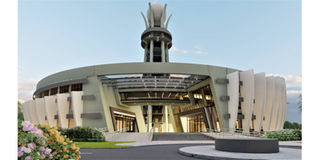Prime
Army to buy more land for Shs110b Katonga museum

The artistic impression of the proposed National Military Museum near River Katonga Bridge. PHOTO | COURTESY
What you need to know:
- The army spokesperson also disclosed that the expansion of the museum acreage will benefit three adjacent landlords who will surrender their certificate of titles to the government after due compensation.
The Uganda People’s Defence Forces (UPDF) is set to buy more land near River Katonga Bridge on the Kampala–Masaka highway where the planned national military museum will be built, the Monitor has established.
On December 29, 2020, President Museveni, who is also the Commander-in-Chief of armed forces, flagged off the project, but the actual construction is yet to commence.
Col Deo Akiiki, the deputy army spokesperson, said two more acres of land, raising the acreage to three, will be enough for the Shs110b project.
An acre of land near Katonga Bridge ranges between Shs25 million and Shs30 million depending on the terrain.
Col Akiiki said the construction works have not started because the available one-acre piece of land isn’t enough to house the museum.
The army spokesperson also disclosed that the expansion of the museum acreage will benefit three adjacent landlords who will surrender their certificate of titles to the government after due compensation.
“So, after realising that the acreage is not enough, a decision was taken to buy more land and the procurement process and valuation is ongoing before compensating the three project-affected persons,” he said in an interview last week.
Col Akiiki revealed that the museum is intended to preserve and conserve the history of the Ugandan military.
A steering committee for the construction of the museum was first chaired by late Lt Gen Pecos Kutesa (RIP), but later replaced with Maj Gen Henry Matsiko, the UPDF chief political commissar, who has rebooted the works.
Col Akiiki said Maj Gen Matsiko’s committee is progressing steadily on documenting the unique and special history of the National Resistance Army (NRA)’s five-year guerrilla war by bringing on board all relevant people who can provide rich information on the NRA war.
“A technical team of researchers instituted by the steering committee is almost through with analysing information gathered from military officers, and civilians who were part of the bush war. So, we hope this will enrich the museum with a satisfying and rich history,” he said.
Col Akiiki added that when such history is recorded, it will be beneficial for the current and future generations.
Mr Yusuf Nsibambi, the MP for Mawokota South Constituency where the museum will be constructed, said they are optimistic that such a facility will boost tourism and increase employment opportunities.
“Such a facility [museum] comes with social services like road infrastructure, electricity, and other social amenities that will improve the standard of living of our people,” he said.
Background
The late Lt Gen Kutesa selected Katonga as the site for the National Military Museum to immortalise as a defining spot, where NRA rebels fought a bloody war to achieve victory. In September 1985, Katonga Bridge was a battlefield between Uganda National Liberation Army (UNLA) soldiers and NRA fighters as the latter attempted to cross to Kampala from Masaka direction. Fighting at the bridge lasted four months and is recorded in Uganda’s military history as one of the bloodiest battles the country has ever witnessed.
After gaining control of the bridge, it made the NRA’s eventual capture of Kampala much easier. Even during the 1979 liberation war that toppled former President Idi Amin Dada, scores of Libyan soldiers who were fighting alongside the Uganda Army (UA), the then national army, were killed at the same bridge. The killing of the Libyan soldiers was a big blow to UA, consequently leading to Amin’s downfall. To remember the fallen Libyan soldiers, the government erected a huge billboard bearing photos of both President Museveni and late Libyan leader Col Muammar Gaddafi.
While breaking the ground of the national military museum in December 2020, President Museveni directed the UPDF to add the portraits of the Late Julius Nyerere (former Tanzanian President) and Samora Machel (former president of Mozambique) to recognise their contribution to the country’s liberation struggle from the early 1970s.




